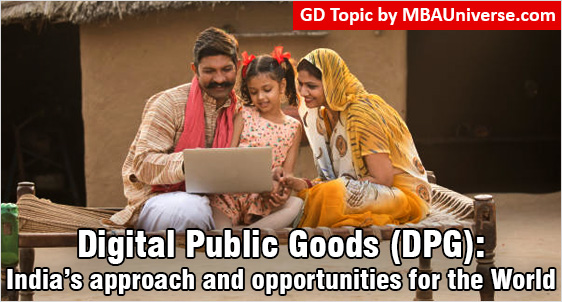
India has demonstrated its digital expertise by building Digital Public Goods (DPG) — the digital identity system “Aadhaar”, many DPGs built on top of Aadhaar and the “Unified Payments Interface”. Aadhaar has become a key enabler to India’s public service delivery architecture. It also facilitated scaling up of many businesses like Reliance Jio and Zerodha, to name a few. UPI has transformed how payments are made. India’s digital public infrastructure is trying to reach the last person, aided by 1.2 billion wireless connections and 800 million internet users.
Also Read
Given the importance of the topic, Digital Public Goods is expected to be a very important topic for Group Discussion, Extempore and Personal Interview for MBA Admissions. MBAUniverse.com presents a compete update on this topic.
What are Digital Public Goods?
Digital Public Goods (DPGs) refer to new and enhanced service delivery of public goods (and services) such as Identity system (Aadhaar), Healthcare, Government Schemes, and other Digital Public infrastructure like Banking & Payments. They are a form of shared infrastructure enabled by using open software, data, content and protocols.
Stacks, the building blocks of Digital Public Goods, comprise of four primary layers. These include:
1- An identity layer that allows personal records to be associated with an online identity
2- A data registry that acts as a single point of truth for both personal and institutional information, thus increasing compatibility amongst all stakeholders
3- Data exchange that facilitates the safe exchange of data across systems, thus enhancing service delivery, innovation and customised solutions
4- An interface that allows applications to communicate through open APIs or software intermediaries, and third parties to build end-user solutions on the stack.
Digital Public Goods by Sectors
Across sectors, India has developed many stacks. Some of these are as follows:
Many other stacks in education, urban development, logistics, and agriculture follow a similarly mapped-out model with identity, data registries, and data exchange components, and are currently in development for Digital Public Goods Alliance.
Centre sets a G20 task force on Digital Public Goods Infrastructure
The government has created a G20 task force on digital public good infrastructure to showcase India’s achievements in these areas to direct global efforts aimed at financial inclusion, health and education. The task force will be co-chaired by G20 Sherpa Amitabh Kant and entrepreneur Nandan Nilekani and will create a detailed map of India’s digital public good infrastructure in finance, health, education, data, taxation, digital commerce and mobility, and shortlist key infrastructure that can be presented within various G20 tracks for adoption by other countries. The other members of the task force will be secretaries of the department of economic affairs, department of financial services, ministry of electronics and information technology and external affairs ministry, deputy governor of the Reserve Bank of India, CEO of Unique Identification Authority of India, managing director of the National Payments Corporation of India and the chief economic adviser
The “G20 Task Force on Digital Public Infrastructure for Economic Transformation, Financial Inclusion and Development” will help achieve the agenda for India’s G20 presidency related to digital public infrastructure, financial inclusion, digital identity, innovative technology-based services such as digital payments system like UPI, and governance frameworks.
“The government is committed to transform India into a digitally empowered society and a knowledge-based economy by ensuring digital access, inclusion, empowerment and bridging the digital divide. Digital infrastructure is its backbone. The world has acknowledged India’s prowess in this area during the Covid period when technology such as CO-WIN was used in the world’s largest vaccination programme,” a government official said.
While speaking at the last G20 Summit in Bali, PM Narendra Modi said digital technologies are crucial for tackling challenges such as poverty, climate change and health. “India’s experience of the past few years has shown us that if we make digital architecture inclusive, it can bring about socio-economic transformation. Digital use can bring scale and speed,” he said.
Views & Comments by Leaders on India’s progress on Digital Public Goods Infrastructure
Microsoft Chief Executive Officer (CEO) Satya Nadella has termed India’s digital public goods infrastructure as “phenomenal” and said the country can lead the world in making the technology and policies work well together for common people.
On January 5, addressing the Microsoft Future Ready Technology Summit in Bengaluru, Nadella said, “It's just unbelievable for me to see the India Stack mature and the use cases between the technology and the policy — there's nothing like that I see anywhere else in the world and it's fantastic for India to lead and then contribute this back to the world.”
Many other global leaders like Sundar Pichai of Google have expressed similar sentiments.
Advantage of the Digital Public Goods
India leveraged Digital Public Goods for benefit of public. Some benefits are:
Challenges for DPGs
Challenges with India’s Digital Ecosystem are also not less. Delivery of Digital Public Goods in developing economy like India poses many challenges, such as:
Given the importance of the topic, Digital Public Goods is expected to be a very important topic for Group Discussion, Extempore and Personal Interview for MBA Admissions. We hope this MBAUniverse.com update is helpful.
Also Check Latest Group Discussion GD Topics
Exam 2024 Notification